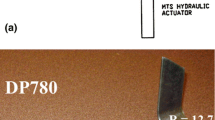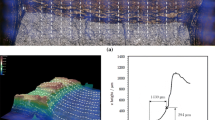Abstract
The effects of martensite volume fraction (MVF) and strain state on necking behavior, post-uniform elongation, and the nucleation and growth of voids in thin sheet dual phase steel, strained in tension, were investigated. Steel containing, in weight percent, 0.08C, 1.45Mn, and 0.21Si, was cold rolled 50 pct and intercritically annealed to produce dual phase microstructures. The effects of MVF were evaluated with a series of constant geometry tensile samples with martensite volume fractions between 5 and 40 pct. The effects of strain state within the neck were evaluated with a series of constant thickness samples with 20 pct MVF and with width variations between 3 and 25 mm. A transition from diffuse to localized necking, as well as a decrease in post-uniform elongation, occurred with both an increase in MVF and sample width. Metallographic analysis of deformed samples revealed that the void nucleation occurs primarily at martensite particles by three distinct mechanisms. The void size and density in the necked region increased toward the fracture surface in all samples and the void density was significantly higher for the samples which exhibited localized necking. However, independent of neck geometry, voids were nucleated uniformly throughout the samples, and were associated with the martensite. The difference in void size and density between the samples with different necking behavior indicates that void growth is a consequence of the strain gradient while the shape of the voids depends on both the strain state and strain gradient. The implications of the void structure analysis are interpreted based on the dual phase microstructure.
Similar content being viewed by others
References
D.K. Matlock, F. Zia-Ebrahimi, and G. Krauss: inDeformation, Processing, and Structure, G. Krauss, ed., ASM, Metals Park, OH, 1984, pp. 47–87.
S. Hayami and T. Furukawa: inMicroalloying 75, Union Carbide Corp., New York, NY, 1975, pp. 311–21.
M. S. Rashid: inFormable HSLA and Dual Phase Steels, A. T. Davenport, ed., TMS-AIME, New York, NY, 1979, pp. 1–24.
R. G. Davies:Metall. Trans. A, 1978, vol. 9A, pp. 41–52.
G. R. Speich and R. L. Miller: inStructure and Properties of Dual- Phase Steels, A. T. Davenport, ed., TMS-AIME, New York, NY, 1979, pp. 58–86.
T. Gladman: inAdvances in the Physical Metallurgy and Application of Steel, The Metals Soc.iety, London, 1982, pp. 65–72.
N. K. Balliger and T. Gladman:Metal Science, 1981, vol. 15, no. 3, pp. 95–108.
W. F. Hosford and R. M. Caddell:Metal Forming, Mechanics and Metallurgy, Prentice-Hall Inc., Englewood Cliffs, NJ, 1983, pp. 68–79.
R. H. VanStone, T. B. Cox, J. R. Low, Jr., and J. A. Psioda:International Metallurgical Reviews, 1985, vol. 30, no. 4, pp. 157–79.
S. P. Keeler and W. A. Backofen:Trans. of ASM, 1963, vol. 56, pp. 25–48.
R. Hill:J. of the Mechanics and Physics of Solids, 1952, vol. 1, pp. 19–30.
W. F. Hosford and R. M. Caddell:J. of the Mechanics and Physics of Solids, 1952, vol. 1, pp. 294–99.
L. F. Ramos, D. K. Matlock, and G. Krauss:Metall. Trans. A, 1979, vol. 10A, pp. 259–61.
N. K. Balliger: inAdvances in the Physical Metallurgy and Application of Steel, The Metals Soc.iety, London, 1982, pp. 73–83.
Li Chengji, D. F. Watt, G. R. Purdy, and A. F. Crawley: inHeat Treatment Shanghai '83, T. Bell, ed., The Metals Society, London, 1984, pp. 5.153–5.163.
R. K. Ray:Scripta Metall., 1984, vol. 18, pp. 1205–09.
A. F. Szewczyk and J. Gurland:Metall. Trans. A, 1982, vol. 13A, pp. 1821–26.
Y. Tomota, H. Yoshino, and K. Kuroki:Scripta Metall., 1977, vol. 11, pp. 853–56.
P. S. Baburamani, R. A. Jago, and R. M. Hobbs: inStrength of Metals and Alloys, R. C. Gifkins, ed., Pergamon Press, New York, NY, 1982, vol. 1, pp. 115–20.
P. Uggowitzer and H. P. Stiiwe:Mat. Sci. and Engr., 1982, vol. 55, pp. 181–89.
A. H. Nakagawa and G. Thomas:Metall. Trans. A, 1985, vol. 16A, pp. 831–40.
Author information
Authors and Affiliations
Additional information
Formerly Graduate Research Assistant, Colorado School of Mines.
Rights and permissions
About this article
Cite this article
Steinbrunner, D.L., Matlock, D.K. & Krauss, G. Void formation during tensile testing of dual phase steels. Metall Trans A 19, 579–589 (1988). https://doi.org/10.1007/BF02649272
Received:
Issue Date:
DOI: https://doi.org/10.1007/BF02649272




